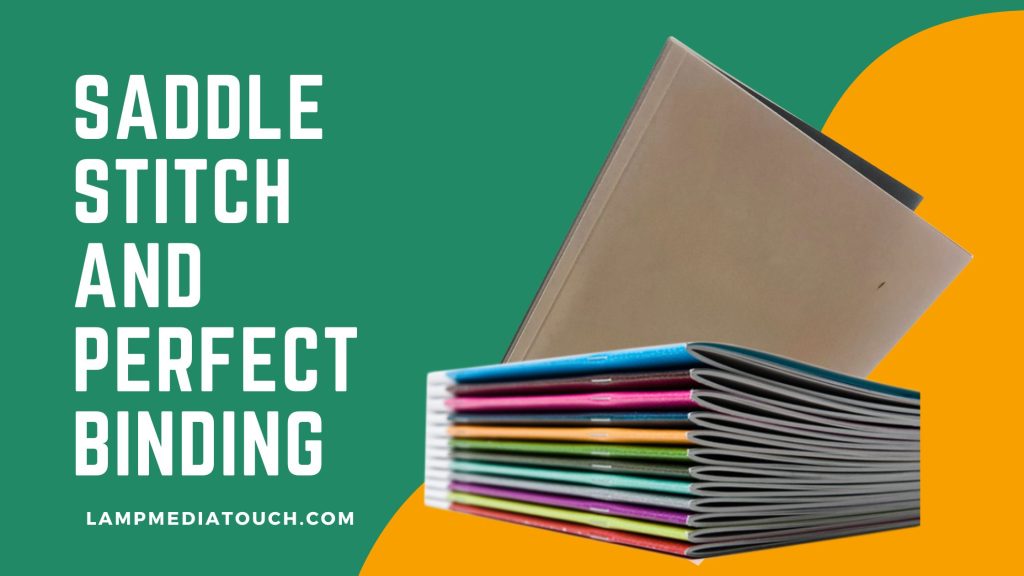In the realm of book binding, two techniques stand out: Saddle Stitch and Perfect Bound. These methods each have their unique advantages and applications. This article discusses the key differences, advantages, and considerations when choosing between Saddle Stitch and Perfect Bound.
A Glimpse into Saddle Stitch and Perfect Bound
Saddle Stitch
Saddle Stitch involves securing pages together by stapling them through the centrefold. This method is typically used for smaller publications like brochures, booklets, and magazines with less than 100 pages.
Perfect Bound
On the other hand, Perfect Bound is commonly utilized for thicker documents like softcover books, magazines, journals, and catalogs. This technique involves gluing the pages to the spine of the book cover, creating a seamless and aesthetically pleasing edge.
Comparing Saddle Stitch and Perfect Bound
Aesthetic Appeal
When it comes to aesthetics, Perfect Bound has a slight edge. This method allows for a seamless connection between the front cover and the spine, creating a smoother and more appealing front edge.
On the other hand, Saddle Stitched books, though less sophisticated, are neat and professional, making them suitable for various types of publications.
Durability
Both binding methods offer decent durability. Perfect Bound books, with their glued spine, can withstand wear and tear, making them ideal for books meant for repeated use.
Saddle Stitch, on the other hand, does not use glue, relying instead on staples. This makes it less durable than Perfect Bound, especially for documents intended for heavy use.
Customizability
Perfect Bound score high on customizability. You can choose any colors and finishes for this type of binding, making it highly adaptable to various design preferences.
Saddle Stitch is less customizable but offers the option of using a self-cover or separate covers, providing some flexibility in design.
Cost and Speed
Saddle Stitch is the less expensive option and has a faster turnaround time than Perfect Bound. This makes it a cost-effective choice for small to large projects, especially when speed is a priority.
Deep Dive into Saddle Stitch and Perfect Bound
Saddle Stitch
How it Works
In Saddle Stitch, full sheets of paper are gathered and stapled together in the center. Then, the book, including the cover, is folded in half along the line of the staple.
Advantages
- Cost-effective binding method
- Fast turnaround time
- Suitable for small or large projects
- Option to use a self-cover or separate cover
Limitations
- Not recommended for books with a high page count
- Page count needs to be in multiples of 4
- Less durable than Perfect Bound
Perfect Bound
How it Works
Perfect Bound involves applying glue to the spine of the pages, which are then attached to the book cover. The front cover is bent to create the spine, and the pages are glued to this section.
Advantages
- Aesthetically pleasing
- Durable and strong
- Allows for wrap-around printing
- Highly customizable
Limitations
- More expensive than Saddle Stitch
- Longer production time
- Not suitable for documents with a low page count
In understanding the practical applications of the two binding methods, it can be helpful to explore real-world examples of each. Let’s dive into some case studies:
Saddle Stitch: The Time Efficiency Model
Case Study: Local Event Programs
A small town’s annual arts festival requires a program guide that includes the event schedule, artist bios, and sponsorship ads. Given the event’s tendency to tweak details up to the last minute, the organizers need a fast and affordable printing solution.
The Solution: Saddle Stitch binding was employed to produce 2,000 program guides. This option was not only cost-effective but also allowed for rapid production, which means that last-minute updates could be incorporated without delaying the distribution of the guides. With a total of 40 pages, the booklets were easy to handle and navigate during the event. The self-covers made from heavier paper stock provided sufficient durability for the short-term use throughout the festivities.
Perfect Bound: The Aesthetic Standard
Case Study: Independent Coffee Table Books
An independent photographer decided to self-publish a high-quality coffee table book featuring a collection of urban landscape images. The book needed to have visual appeal to stand out in bookstores and also be durable enough for repeated browsing.
The Solution: The photographer chose Perfect Bound Binding for the 120-page book. The method offered a sleek and professional appearance, with a flat spine that allowed title printing, enhancing visibility on bookshelves. The durability of the glued pages meant the book could endure frequent handling, and the higher cost of production was offset by the added value perceived by customers, who were willing to pay more for a premium product. The finished product not only projected the desired high-end feel but also served as a durable portfolio of the photographer’s work.
Making the Right Choice
When choosing between Saddle Stitch and Perfect Bound, consider the nature of your project. If you’re working on a small booklet or brochure with a limited number of pages, Saddle Stitch may be the better option. However, if you’re publishing a soft cover book or journal with a high page count, Perfect Bound might be more suitable.
Remember, the choice between Saddle Stitch and Perfect Bound depends on various factors, including your budget, project requirements, and aesthetic preferences. Therefore, it’s important to consider all these aspects before making a decision.
To order the best printing and binding services for your materials, look for a trusted printing service provider that can guide you in choosing the right binding technique for your specific project.
Conclusion
In the end, both Saddle Stitch and Perfect Bound have their unique benefits and drawbacks. The key is to understand what each method offers and how it aligns with your project requirements. By doing so, you can make an informed decision that will result in a professionally bound book that meets your expectations.
Remember, the choice of binding technique can significantly impact the look, feel, and durability of your book. Therefore, choose wisely!

